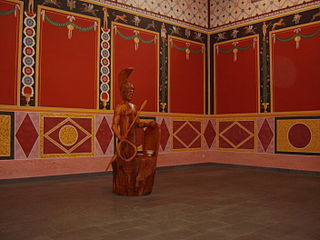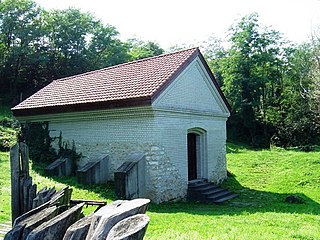The Frisians are a Germanic ethnic group indigenous to the coastal regions of the Netherlands and northwestern Germany. They inhabit an area known as Frisia and are concentrated in the Dutch provinces of Friesland and Groningen and, in Germany, East Frisia and North Frisia. The name is probably derived from frisselje. The Frisian languages are spoken by more than 500,000 people; West Frisian is officially recognised in the Netherlands, and North Frisian and Saterland Frisian are recognised as regional languages in Germany.

Týr is a god in Germanic mythology, a valorous and powerful member of the Æsir and patron of warriors and mythological heroes. In Norse mythology, which provides most of the surviving narratives about gods among the Germanic peoples, Týr sacrifices his hand to the monstrous wolf Fenrir, who bites it off when he realizes the gods have bound him. Týr is foretold of being consumed by the similarly monstrous dog Garmr during the events of Ragnarök.

In Celtic mythology, Nantosuelta is the goddess of nature, the earth, fire, and fertility.
In Romano-British culture and Germanic polytheism, the Alaisiagae were a quartet of Celtic and Germanic goddesses deifying victory.

A thing, also known as a folkmoot, assembly, tribal council, and by other names, was a governing assembly in early Germanic society, made up of the free people of the community presided over by a lawspeaker. Things took place at regular intervals, usually at prominent places that were accessible by travel. They provided legislative functions, as well as being social events and opportunities for trade. In modern usage, the meaning of this word in English and other languages has shifted to mean not just an assemblage of some sort but simply an object of any sort.

In ancient Roman religion, a votum, plural vota, is a vow or promise made to a deity. The word comes from the past participle of the Latin verb voveo, vovere, "vow, promise". As the result of this verbal action, a votum is also that which fulfills a vow, that is, the thing promised, such as offerings, a statue, or even a temple building. The votum is thus an aspect of the contractual nature of Roman religion, a bargaining expressed by do ut des, "I give that you might give."

The Tropaeum Traiani or Trajanic Trophy is a monument in Roman Civitas Tropaensium, built in AD 109 in then Moesia Inferior, to commemorate Roman Emperor Trajan's victory over the Dacians, in the winter of 101–102, in the Battle of Adamclisi. Before Trajan's construction, an altar existed there, on the walls of which were inscribed the names of the 3,000 legionaries and auxilia (servicemen) who had died "fighting for the Republic"..
The Tubantes were a Germanic tribe, living in the eastern part of the Netherlands, north of the Rhine river. They are often equated to the Tuihanti, who are known from two inscriptions found near Hadrian's Wall. The modern name Twente derives from the word Tuihanti.

Lenus was a Celtic healing god worshipped mainly in eastern Gaul, where he was almost always identified with the Roman god Mars.

Veraudunus is the name of a Celtic god known only from two votive inscriptions found in Luxembourg. One of these inscriptions suggests that ‘Veraudunus’ may have been an epithet of the important Treveran god Lenus Mars. In both inscriptions, Veraudunus is invoked along with Inciona.
Ocelus is a Celtic god known from three inscriptions in Roman Britain. He is twice invoked on dedications at Caerwent: one stone is the base of a statue of which only a pair of human feet and a pair of goose feet survive. The invocation is to Mars Lenus or Ocelus Vellaunus and the "numen" (spirit) of the emperor, and was dedicated on 23 August AD 152. The second Caerwent inscription dedicates an altar to Mars Ocelus. The god was also venerated at Carlisle, where he was once more equated with Mars and again linked to the imperial cult. So Ocelus seems to have been a British, perhaps Silurian god, associated with Mars, probably in the latter's Celtic capacity as a protector. At Caerwent he is linked with Lenus, a Treveran healing deity, and with Vellaunus, who is recorded among the Gaulish Allobroges.
Vellaunus is a Celtic god known from two inscriptions.

Aignay-le-Duc is a commune in the Côte-d'Or department in the Bourgogne-Franche-Comté region of eastern France.

The Fertőrákos Mithraeum is a temple to the Roman god Mithras at Fertőrákos in Hungary. The temple, follows a typical plan of a narthex followed by the shrine proper that consists of a sunken central nave with podium benches on either side.
Rudchester Mithraeum is a Roman temple to the Roman god Mithras at Rudchester (Vindobala), an auxiliary fort on Hadrian's Wall, the northern frontier of Roman Britain. The temple was located 137m to the west of the castra. It is not currently visible to visitors to the site.

In ancient Roman religion and myth, Mars was the god of war and also an agricultural guardian, a combination characteristic of early Rome. He was the son of Jupiter and Juno, and was pre-eminent among the Roman army's military gods. Most of his festivals were held in March, the month named for him, and in October, which began the season for military campaigning and ended the season for farming.
Hercules Magusanus is a Romano-Germanic deity or hero worshipped during the early first millennium AD in the Lower Rhine region among the Batavi, Marsaci, Ubii, Cugerni, Baetasii, and probably among the Tungri.

Navio Roman fort overlooks a tight bend of the River Noe at Brough-on-Noe near Hope, Derbyshire, in England. Navio fort and vicus is a Scheduled Monument.
The Dexivates were a small Gallic tribe dwelling in the southern part of modern Vaucluse, near the present-day village of Cadenet, during the Iron Age and the Roman period.
Rigisamus, also Rigisamos, was a deity in Gaulish and Celtic mythology who, according to the Interpretatio Romana, was connected with Mars.











